KucherAV/iStock/GettyImages
Thick, massive steaks are decidedly the best when you have the time to cook them properly, but that's not always going to be the case. If you've invested in some high-end cuts but won't have the time to do them justice, butterflying them is one way to enjoy that top-quality steak with less cooking time. It requires a sharp knife and a steady hand but isn't overly difficult.
The Goal
A properly butterflied steak is cut most – but not all – of the way through, leaving a small portion of the meat intact to serve as a sort of hinge. The two halves of the steak should be identical in thickness so they'll cook evenly, and the cut should be smooth so the inner surfaces aren't marred by multiple slash marks. If your steak has a rind of fat at one side, as some do, you should cut from that side so the fat provides an outer border to the entire steak. After you're clear on the desired end result, it's time to move on to the actual cutting.
Butterflying Your Steak
If you're working with a rib steak, wing steak or anything else with a bone in it, removing the bone is your first step. Hold the steak on your cutting board and run a sharp knife along the bone, separating it from the meat as neatly as possible. You can use the bone in your next batch of beef broth, or – if you didn't clean it as neatly as you'd have liked – throw it on the grill alongside the steak, and gnaw the meat from it later as an additional treat. After the bone is removed, you're ready to start butterflying.
- Lay the steak on your cutting board, with the rim of fat facing your knife hand. If there's no fat cap, either side is fine.
- Hold the knife horizontally, and lightly score a line at the midpoint of the steak to mark the point where you'll cut.
- Grasp the knife in one hand and place the other hand flat on the surface of the steak, to hold it in place on the cutting board and to immobilize it as your knife moves through the flesh.
- Place the knife on the line you've marked at the steak's edge. If there's a fat cap to cut through, make a long stroke with your knife to sever it, but stop as soon as you reach the meat of the steak itself.
- With the knife's blade held firmly against the edge of the steak, cut into it with a long, smooth stroke. Ideally you'd like to butterfly the steak completely all in the one motion, to make the neatest possible cut, but that's not always possible. Stop when your blade is roughly 1/4 to 3/8 inch from the back edge of the steak so that there's enough meat left to act as a hinge.
- Open up the steak to evaluate your cut. You might need to make another, smaller cut to open up the middle evenly.
- Unfold your steak like a book, so the surface you've just sliced is the top side. It might not want to stay open, but that's fine: Press it down with the flat of your knife, or place a heavy plastic bag over it and pummel it gently with a meat mallet or rolling pin.
A Few Pointers
You'll want to use a very sharp knife for this. Ideally it should be one with a narrow blade rather than a wide blade, simply because the narrow blade will tug at the meat less as you cut, but sharpness is more important than blade shape. Use the sharpest knife you have that's big enough to cut through the steak. It also helps if the steak is partially frozen, which firms up the meat and makes it easier to achieve a neat cut. Depending on the thickness of your steak, 15 to 30 minutes in the freezer should do it.
Pros and Cons
Before you put the knife to your steak, it's worth taking a moment to consider if that's really what you want to do. The benefits of butterflying the beef are pretty straightforward: It'll cook much more quickly, and by butterflying it you've effectively doubled its surface area. That means you'll have twice as much surface to sear, and lots more of the rich, savory flavors that come from searing. On the other hand, the thinner a steak becomes, the more difficult it is to get a deeply seared exterior while still keeping the inside rare or medium-rare. If you like your steaks done medium or well that might not be an issue, but if you prefer them lightly cooked, you might find the end result to be a bit disappointing. The added size also means your steaks will take up twice as much space in your pan or on your grill, so it can be harder to serve everyone in a reasonable time frame.
Related Articles

How to Carve a Bottom Round Roast Into ...

Can Beef Shoulder Roast Be Sliced and ...
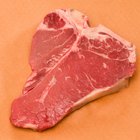
How to Score a Steak
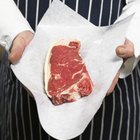
Tenderloin Filet Vs. Top Sirloin
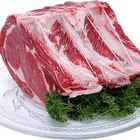
How to Debone a Ribeye
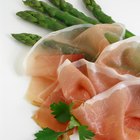
How to Cut Prosciutto

How to Cook Ultra Thin Sirloin

How to Cook Deer Sirloin
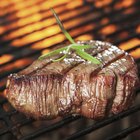
How to Grill a Whole Filet Mignon

How to Clean Mullet

How to Cook London Broil
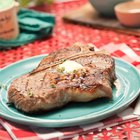
How to Grill T-Bone Steaks
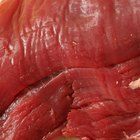
How to Peel a Beef Tenderloin

How to Cook a Pork Shoulder Blade Steak

Does a Rib Eye Have a Filet in It?
How to Cook Buffalo Fillet

How to Choose a Ribeye Steak

What Is a Rib-Eye Steak?

How to Get Skirt Steak Tender
How to Trim the Fat When Cooking Lamb
References
Resources
Warnings
- Avoid butterflying bone-in steaks, as it will be difficult to cut evenly around the bone.
Writer Bio
Fred Decker is a trained chef and prolific freelance writer. In previous careers, he sold insurance and mutual funds, and was a longtime retailer. He was educated at Memorial University of Newfoundland and the Northern Alberta Institute of Technology. His articles have appeared on numerous home and garden sites including GoneOutdoors, TheNest and eHow.